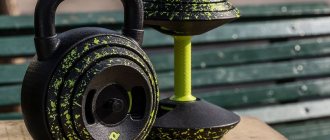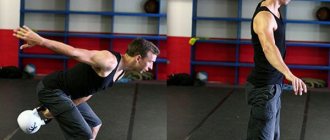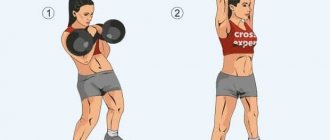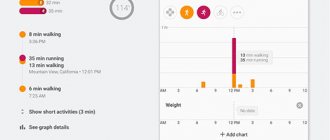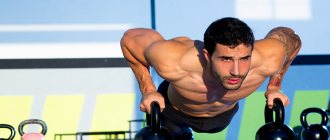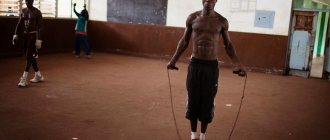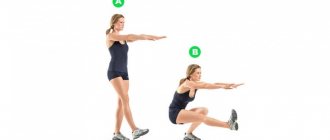Share:
Turkish get-ups are an exercise that came to CrossFit from wrestling. Traditionally, this exercise is performed by sambists and jiu-jitsu practitioners with a kettlebell. It is used to develop a quick rise to a standing position from a lying position. In CrossFit it can act as an element of WODs, or as an independent movement that develops such quality as intermuscular coordination.
Turkish get up with kettlebell: video
Recommendations
Italian chicken cacciatore
Keep your hand in the same plane as your forearm, the handle of the weight rests on your palm; The fingers should not bear the entire weight of the projectile; You should not push off with your feet and straighten your knees; Presses should be in the same plane; You should not actively move your body weight from toe to heel; You need to start with adequate kettlebell weights. Many people have only standard 12, 16, 24 and 36 kg at their disposal
If this weight doesn't suit you, check out CrossFit kettlebells; The movement of the kettlebell should not be jerked; the jerk amplitude is not practiced with pressure; this can lead to injury to the elbow joint; The body is kept fixed by holding the core and back muscles; At the top point of the amplitude, the arm should be fully straightened; Leaving your elbows slightly bent or holding the kettlebell handle on your fingers is not safe.
Rules for performing the exercise
- Lie on your back. Take the weight and lift it above you so that the line of your arm is perpendicular to the floor level.
- Hold the kettlebell in a given position and at the same time change the position of your body: first sit on the floor, then stand. When performing the exercise, help yourself with your free hand. Throughout the entire exercise, your gaze is directed at the weight.
- First, raise your body, then squat down and only then rise on both legs. Return to starting position and repeat.
You can learn more about the technique of performing the exercise in the following video.
Important! Always keep an eye on the kettlebell and hold it above your head, the entire trajectory of the kettlebell should be perpendicular to the floor, then you will not lose control of the kettlebell and will be able to stand up without the risk of injury.
Turkish squats: 13 not the easiest steps
STEP 1: Starting position
Lie on the floor on your back. Place the weight next to your right shoulder.
STEP 2: Lifting the Kettlebell
Roll to the right, keeping your right elbow close to your body, and grab the kettlebell in your right hand. Then roll onto your back and gently lower the weight to your chest. The left arm is extended on the floor, at an angle of about 45 degrees to the body. The left leg is straight. Bend your right leg so that your foot is flat on the floor. With your right hand, slowly lift the weight up, straightening your right elbow. Keep your eyes on the kettlebell at all times throughout the exercise.
STEP 3: On the elbow
With your right foot firmly planted on the floor, roll onto your left elbow while continuing to hold the kettlebell up. This is similar to an elbow-supported partial squat—you should be resting on your left buttock.
STEP 4: On hand
Once you're stable on your elbow, continue the roll until you're leaning on your left hand. Now you have three points of support - your left arm, your right foot and your left buttock.
STEP 5: High Bridge
Squeeze your glutes and lift your hips off the ground, keeping your arm completely vertical. Don't take your eyes off the weights! Now you only have two points of support (left arm and right leg) since your hips are no longer touching the ground.
STEP 6: Bend the leg
With your hips high, tuck your left leg under you, back toward where your knee rests on the floor beneath you. You should eventually end up in a position where your legs are at about 90 degrees to each other. One knee will point forward and the other will point toward your hand on the floor. The neck should be stretched upward, look at the weight.
STEP 7: Rising
Lift your left hand off the floor and straighten up. Move your foot on the floor until both legs are parallel to each other in a lunge position.
STEP 8: Get up
Starting with your back leg, through your hips to your front leg, stand up from a lunge position, still holding the kettlebell above you, bracing your core as you rise. Bring your legs together. Take a breath... half way there!
STEP 9: Reverse Lunge
Lunge back so that your left knee returns to the floor. Keep the kettlebell held high.
STEP 10: Move the leg and rotate the hip
Move your left leg until it is perpendicular to your right. Bend your hips and place your left hand directly in front of your knee on the floor.
STEP 11: Extend your leg
Step your left leg forward until it is directly in front of you, pressing your heel into the floor while supporting yourself with your left hand.
STEP 12: Back to Elbow
Very slowly, carefully controlling yourself, lower your buttocks to the floor, lowering yourself onto your left forearm.
STEP 13: Finished, repeat
Very slowly lower your body down onto your shoulders and back, keeping your eyes on the weight above you. Slowly lower her onto her stomach. Roll onto your side and place her on the floor. Congratulations! The first repetition is completed and you are ready for the second.
Description of the exercise
The Turkish get-up is an excellent functional exercise that develops the muscles of the entire body, trains coordination and balance. It will be difficult for beginners to immediately cope with this exercise 100%. You should start doing it gradually, first try doing the Turkish get-up without weights.
The exercise can be performed with a kettlebell, dumbbells or any object suitable for you.
Why is the rise Turkish?
History says that 200 years ago this exercise was used by Turkish wrestlers. They tested their strength with this test: they had to take a 50 kg weight, lie on the floor with it, and then stand up, holding it at arm's length. Of course, no one says that you need to take so much weight right away, but gradual development will help you achieve any results.
What muscles work?
The muscles that are used by the Turkish get-up are presented in the table:
| Part of the body | What works? |
| legs | quadriceps, calf muscles |
| press | rectus, oblique muscles |
| hands | triceps and deltoid muscles |
| breast | major and minor muscles, serratus anterior muscles |
| back | spine and pelvis in stabilization mode |
Tips for doing the exercise
- Place Turkish get-ups at the beginning of your workout. If you're tired, you'll have a harder time coordinating yourself, and you'll also do far fewer reps.
- Don't chase too many reps.
- Add working weights gradually and start with small ones.
- Take a video of yourself. If there is no trainer nearby, this is a great way of self-control.
- If possible, do the exercise barefoot. Some types of shoes (especially running shoes) make it difficult to maintain stability and balance.
How to Get the Most Out of Squats
Turkish squats are very intense and involve a lot of moving body parts, so start with light (or no) weights.
until you master the movements. Try using a shoe instead of a kettlebell first, just to understand the correct body mechanics.
As Amy Rushlow says, “Don’t be surprised if you look like a drunk the first time.” Beginners should start with a kettlebell weighing 5-7 kg, at best
.
Nine kilograms is an intermediate stage for this exercise, and 11-14 kg is already for experienced ones.
If you immediately grab the strongman weights, you risk injury.
Between each position, pause and catch your breath, mentally checking your form and trying to monitor the strength of your joints and core muscles. If you can't complete a full rep correctly, it's best to stop rather than persist and risk injury.
Remember that the benefits of this exercise come from the quality of the movement, not the amount of weight.
12-15 reps are great.
On the other hand, you can perform 1-3 repetitions on each side as a warm-up. Remind yourself not to rush - each repetition should take 45 to 60 seconds.
Alternative Exercises
Bent-over kettlebell press. This exercise is aimed at working the abdominal muscles and the entire shoulder body. Learn the correct technique for performing the exercise, and it will become indispensable in your training program.
Bent-over kettlebell press
Alternating rope swings. The exercise is performed with a heavy and durable rope and represents high-intensity functional training. Rope training helps develop strength, endurance and strengthens the cardiovascular system.
Alternating rope swings
Ball throws. an exercise borrowed from boxing and currently actively used in crossfit. In the process of throwing a medicine ball at a target, the most important muscle groups for striking martial arts work - the leg muscles, anterior deltoids, pectoral muscles, triceps, intercostal muscles, oblique and rectus abdominis muscles .
Ball throws (CrossFit)
Interesting Facts
The lift was used to train wrestlers and circus athletes for security forces in Turkey, hence the name. It was initially regarded as a trick; Pavel Tsatsouline, an American kettlebell expert of Russian origin, believes that the Turkish lift is the most difficult kettlebell exercise and in the training of athletes it should begin after the athlete learns to perform normal movements, for example, swings, snatches and jerks ;In competitive CrossFit, this exercise can be included in complexes and then it should be performed at a fast pace, but without losing technique, so CrossFitters must do the Turkish get-up with almost no weight to practice the skill; In kettlebell training schools, they often draw diagrams of the Turkish get-up on posters so that the students did not confuse the sequence of movements. The exercise is very popular among various fans of functional training. For example, it is even included in Jillian Michaels' video program.
The Turkish get up is a challenging but fun exercise that is worth mastering for anyone who wants to take their body control to a whole new level.
Translation of "bench press" into Turkish: "bench press"
| source complain Langcrowd.com | |
| bench press | bench press source complain Langcrowd.com |
| Bench press | Tezgah basın source complain Langcrowd.com |
| Well, then, press-press, smack-smack. OU. | Anlarsın ya, öpüşmeler sarılmalar. source complain Corpus name: OpenSubtitles2016. License: not specified. References: https://opus.lingfil.uu.se/OpenSubtitles2016.php, https://stp.lingfil.uu.se/~joerg/published/ranlp-V.pdf |
| FLAT BENCH PRESS | FLAT BENCH PRESS source complain Langcrowd.com |
| | |
| overhead press | biz başınızın üzerinde basın source complain Langcrowd.com |
| Well, you know, abs, bench press. | Göğüs presi, yerden kaldırma? source complain Corpus name: OpenSubtitles2016. License: not specified. References: https://opus.lingfil.uu.se/OpenSubtitles2016.php, https://stp.lingfil.uu.se/~joerg/published/ranlp-V.pdf |
| One-arm standing press. | Tek elle kaldırma. source complain Corpus name: OpenSubtitles2016. License: not specified. References: https://opus.lingfil.uu.se/OpenSubtitles2016.php, https://stp.lingfil.uu.se/~joerg/published/ranlp-V.pdf |
| ONE-ARM PRESS M.R. 273 14 LIVRE | TEK ELLE AĞIRLIK KALDIRMADA DÜNYA REKORU: 124 kg source complain Corpus name: OpenSubtitles2016. License: not specified. References: https://opus.lingfil.uu.se/OpenSubtitles2016.php, https://stp.lingfil.uu.se/~joerg/published/ranlp-V.pdf |
| I would never have believed it if I hadn't seen his bench press. | Göğüs basışını görene kadar inanmamıştım. source complain Corpus name: OpenSubtitles2016. License: not specified. References: https://opus.lingfil.uu.se/OpenSubtitles2016.php, https://stp.lingfil.uu.se/~joerg/published/ranlp-V.pdf |
| Ladies and gentlemen, that was a two-hand press, three reps, with 285 pounds! | Bayanlar baylar! İki elle üç tekrar 130 kg. source complain Corpus name: OpenSubtitles2016. License: not specified. References: https://opus.lingfil.uu.se/OpenSubtitles2016.php, https://stp.lingfil.uu.se/~joerg/published/ranlp-V.pdf |
| My name is J-z-z-zhim Halpert, I will fax and re-fax you. I'll fax it to you. | Tamam, benim adım Jim Halpert ve sizden fakslarım sizde sizde fakslarım. source complain Corpus name: OpenSubtitles2016. License: not specified. References: https://opus.lingfil.uu.se/OpenSubtitles2016.php, https://stp.lingfil.uu.se/~joerg/published/ranlp-V.pdf |
| (note by the author of the translation: Apparently they meant the French standing press) They talked about it. | Louie, bunu kolların için yapmış olman gerekirdi. source complain Corpus name: OpenSubtitles2016. License: not specified. References: https://opus.lingfil.uu.se/OpenSubtitles2016.php, https://stp.lingfil.uu.se/~joerg/published/ranlp-V.pdf |
| - go do some chest presses, and I have something to do here. | Neden kendine şınav çekmek için bir bank bulmuyorsun? Benim işim var. source complain Corpus name: OpenSubtitles2016. License: not specified. References: https://opus.lingfil.uu.se/OpenSubtitles2016.php, https://stp.lingfil.uu.se/~joerg/published/ranlp-V.pdf |
Translation of "press-press" in English, German, Italian, French, Spanish, Portuguese, Polish, Arabic, Hebrew, Japanese, Dutch, Latin, Persian, Azerbaijani, Armenian, Georgian, Kazakh, Kyrgyz, Tajik, Tatar, Ukrainian, Uzbek , Belarusian
